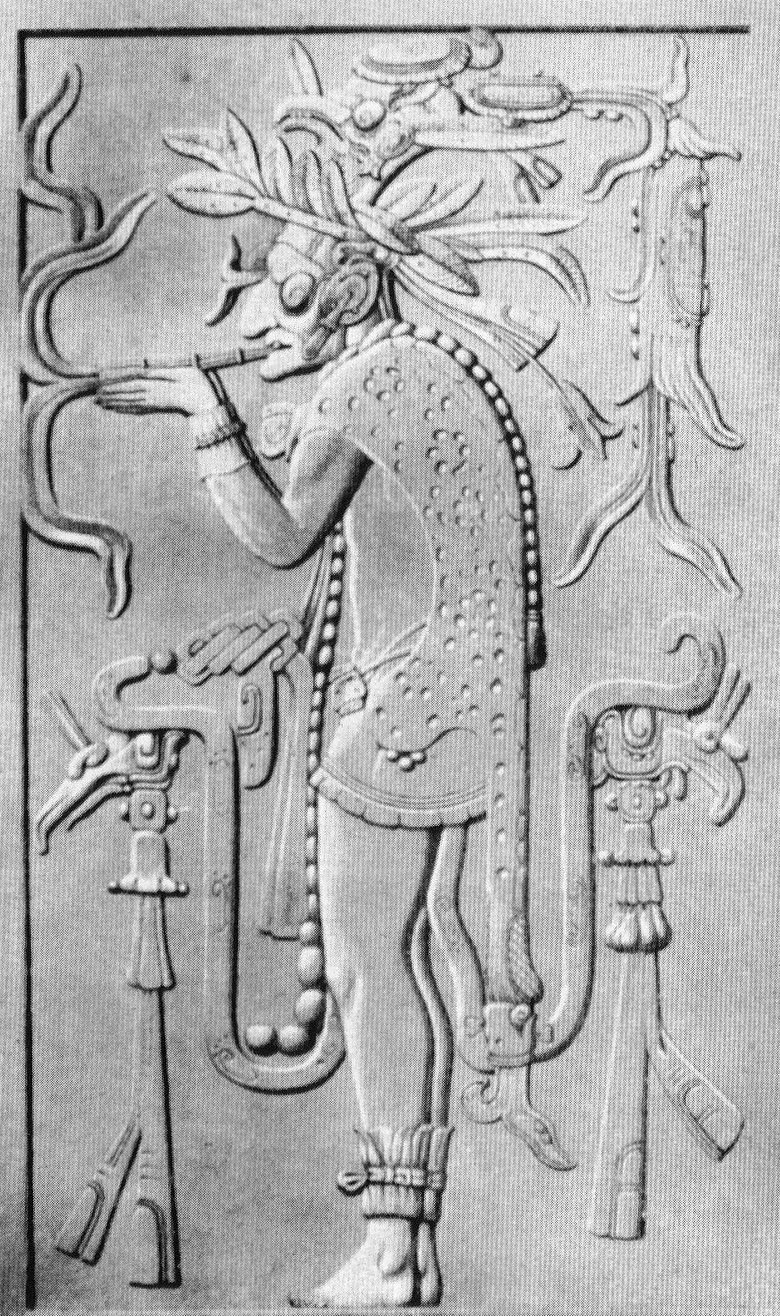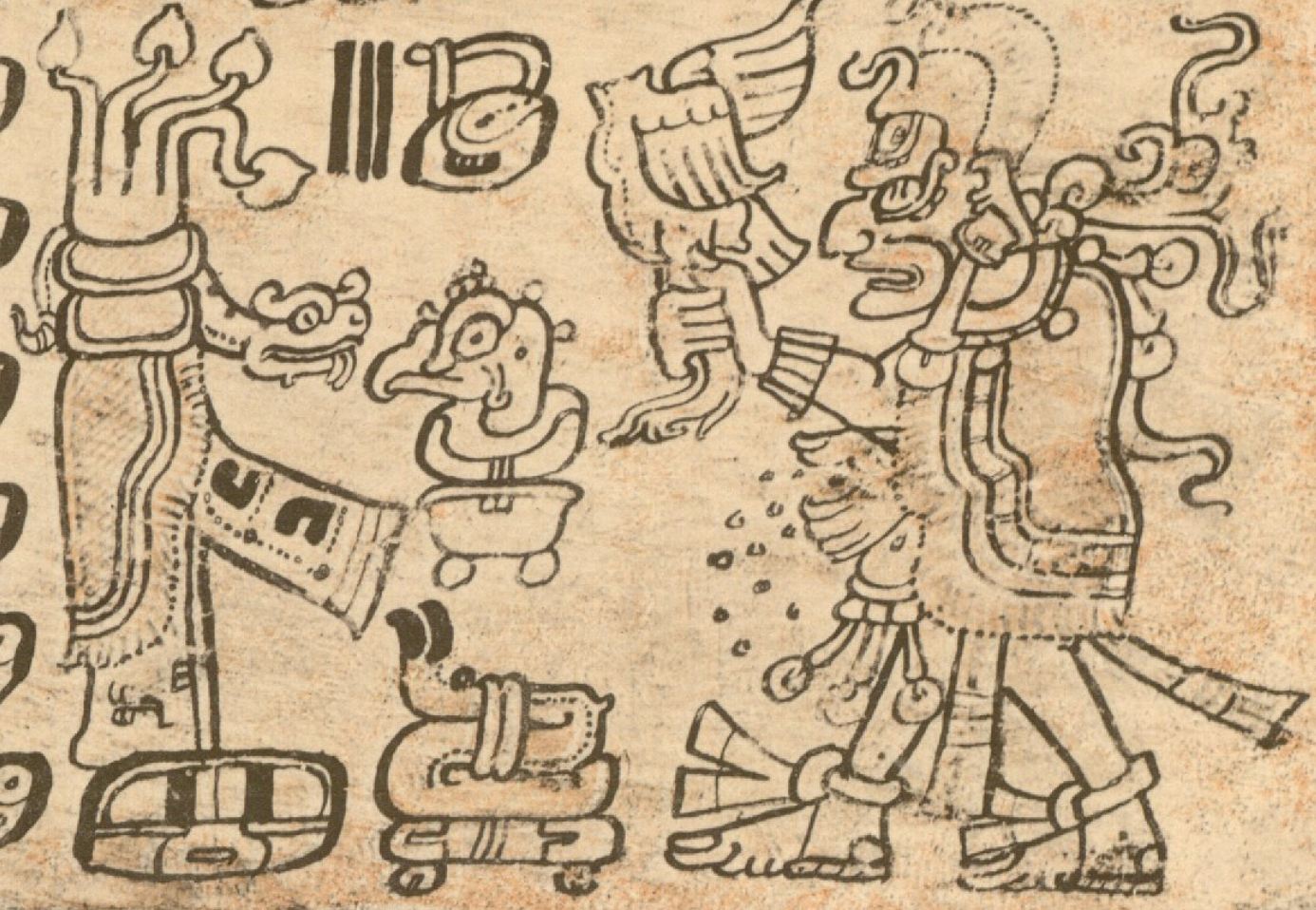God L on:
[Wikipedia]
[Google]
[Amazon]
 God L of the Schellhas-Zimmermann-Taube classification of codical gods is one of the major pre-Spanish
God L of the Schellhas-Zimmermann-Taube classification of codical gods is one of the major pre-Spanish

 God L of the Schellhas-Zimmermann-Taube classification of codical gods is one of the major pre-Spanish
God L of the Schellhas-Zimmermann-Taube classification of codical gods is one of the major pre-Spanish Maya deities
This is a list of deities playing a role in the Classic (200–1000 CE), Post-Classic (1000–1539 CE) and Contact Period (1511–1697) of Maya religion. The names are mainly taken from the books of Chilam Balam, Lacandon ethnography, the Madr ...
, specifically associated with trade. Characterized by high age, he is one of the Mam ('Grandfather') deities. More specifically, he evinces jaguar traits (particularly the ear), a broad feathery hat topped by an owl, and a jaguar mantle or a cape with a pattern somewhat resembling that of an armadillo shell. The best-known monumental representation is on a doorjamb of the inner sanctuary of Palenque's Temple of the Cross.
Name
The main sign of god L's name glyph in theDresden Codex
The ''Dresden Codex'' is a Maya book, which was believed to be the oldest surviving book written in the Americas, dating to the 11th or 12th century. However, in September 2018 it was proven that the Maya Codex of Mexico, previously known as th ...
consists of the head of an aged man painted black. The reading is unknown, but may conceivably have been Ekʼ Chuah (see below).
Functions
Attributes and scenes of god L are indicative of at least three main functions.Wealth
Recurrent attributes are a bundle of merchandise and a walking-stick. The floating ends of god L's cloth can show footsteps, again pointing to travelling merchants. In view of the further functions of god L, the Maya merchants should perhaps be compared to the Aztec ''nahualoztomecah'', warriors disguised as merchants. The wealth of god L has been suggested to refer specifically to the cacao orchards of the Gulf Coast; inCacaxtla
Cacaxtla () is an archaeological site located near the southern border of the Mexican state of Tlaxcala. It was a sprawling palace containing vibrantly colored murals painted in unmistakable Maya style. The nearby site of Xochitecatl was a more ...
, god L is associated with maize stalks and cacao trees. God L's wealth seems to include women as well. On the Princeton vase (see figure), god L is surrounded by five young women, whereas in the Dresden Codex (14c2), he holds a young woman ( goddess I) with a maize sign.
Magic and Shamanism
The cigar which, more often than not, is smoked by god L suggests theapotropaic magic
Apotropaic magic (from Greek "to ward off") or protective magic is a type of magic intended to turn away harm or evil influences, as in deflecting misfortune or averting the evil eye. Apotropaic observances may also be practiced out of supers ...
of a merchant or, perhaps, the habit of a shaman. The owl on the hat points a connection to the underworld and night, and recalls the Nahua term for sorcerer, ''tlacatecolotl'' 'Man-Owl'. The jaguar is also a reference to night and the underworld.
War
God L's jaguar and owl (''kuy'') attributes point to sorcery, violence, and warfare, qualities that may be related to his Postclassic role as a personification of Venus rising from the underworld, and throwing spears at his victims (Dresden Codex). God L's connection to warfare is also suggested by the decapitation of a bound prisoner, perhaps a captive king, in front of god L's jaguar palace (Princeton vase). On the central relief of the Palenque Temple of the Sun - a war temple - god L, together with one of the otherMaya jaguar gods
The pre-Columbian Maya religion knew various jaguar gods, in addition to jaguar demi-gods, (ancestral) protectors, and transformers. The main jaguar deities are discussed below. Their associated narratives (part of Maya mythology) are still la ...
(viz. the Jaguar God of Terrestrial Fire), supports an emblem consisting of the sacred shield and lances of the Palenque kings. His submissive posture suggests he now represents a defeated enemy chief.
Connections to other deities
*God M. As a merchant deity, god L is paralleled by another, Postclassic merchant god, the black god M (Madrid Codex). * Ek Chuah. A Yucatec merchant god who, like god L, was connected to cacao orchards, bore the name Ek Chuah (Landa). This name is usually connected to god M, but could as well refer to god L. *Bolon-Yokte. Together with the deity Bolon-Yokte ('Nine-Strides'), god L and god M have been argued to represent the abstract idea of travelling and of movement in space and time. *God K. God L is often combined withgod K
In monotheistic thought, God is usually viewed as the supreme being, creator, and principal object of faith. Swinburne, R.G. "God" in Honderich, Ted. (ed)''The Oxford Companion to Philosophy'', Oxford University Press, 1995. God is typically ...
, the lightning deity who, as an owner of the seeds, was considered a bringer of abundance. More specifically, god L can extend the head of god K, or carry an infant god K in a sling on his back. God K also happens to be the victim of god L as a Venus patron (Dresden Codex).
*Itzamna. It has been suggested that God L is the underworld counterpart of Itzamna
Itzamna () is, in Maya mythology, an upper god and creator deity thought to reside in the sky. Itzamna is one of the most important gods in the Classic and Postclassic Maya pantheon. Although little is known about him, scattered references are pre ...
, the supreme Maya deity.
Ritual
The ''acantun
Acantuns are ritual stone shafts placed at the four corners of a Yucatec Maya village. When night fell, four Balams (Jaguars) were said to arrive and sit on the idols to keep guard over the village.
References
*
*
*
Maya mythology and rel ...
'' stone shafts depicted in the Dresden Codex, which were venerated during the five unlucky and dangerous days (''wayeb'') at the end of the year, are draped with the mantle and footprint-marked loincloth of God L.

Narrative scenes
Narrative scenes on pottery show the denudation and clothing of god L, while focussing on his owl hat, mantle, and staff. These scenes involve theMaya moon goddess
The traditional Mayas generally assume the Moon to be female, and the Moon's perceived phases are accordingly conceived as the stages of a woman's life. The Maya moon goddess wields great influence in many areas. Being in the image of a woman, she ...
, the rabbit, the Tonsured Maize God
Like other Mesoamerican peoples, the traditional Maya recognize in their staple crop, maize, a vital force with which they strongly identify. This is clearly shown by their mythological traditions. According to the 16th-century Popol Vuh, the Hero ...
, the Hero Twins
The Maya Hero Twins are the central figures of a narrative included within the colonial Kʼicheʼ document called Popol Vuh, and constituting the oldest Maya myth to have been preserved in its entirety. Called Hunahpu and Xbalanque in the Kʼic ...
, and also (in a Dresden Codex vignette) Chaak
Chaac (also spelled Chac or, in Classic Mayan, Chaahk ) is the name of the Maya god of rain, thunder, and lighting. With his lightning axe, Chaac strikes the clouds, causing them to produce thunder and rain. Chaac corresponds to Tlaloc among ...
, the Rain Deity. In this connection, god L has been interpreted (in terms of the Popol Vuh
''Popol Vuh'' (also ''Popol Wuj'' or ''Popul Vuh'' or ''Pop Vuj'') is a text recounting the mythology and history of the Kʼicheʼ people, one of the Maya peoples, who inhabit Guatemala and the Mexican states of Chiapas, Campeche, Yucatan and ...
hero myth) as one of the principal lords of the Underworld, or Xibalba
(), roughly translated as "place of fright", is the name of the underworld (or quc, Mitnal) in Maya mythology, ruled by the Maya death gods and their helpers. In 16th-century Verapaz, the entrance to Xibalba was traditionally held to be a ...
.
Presence in contemporary Maya religion
It has been suggestedChristenson 2001: 186-190 that god L corresponds to that most famous of all Tzʼutujil deities, the cigar-smoking 'Grandfather' ('' Mam'')Maximón
Maximón (), also called San Simón, is a Mayan deity and folk saint represented in various forms by the Maya peoples of several towns in the Guatemalan Highlands. Oral tradition of his creation and purpose in these communities is complex, diverse ...
, whose manifold associations include long-distance travel, witchcraft, and jaguars, and who is especially venerated during the last days of Holy Week. In the cult of Maximón, the latter's cloths receive special emphasis.
References
Citations
Sources
* Coe, Michael D., Lords of the Underworld: Masterpieces of Classic Maya Ceramics. 1978 * Christenson, Art and Society in a Highland Maya Community. 2001 * Gillespie and Joyce, Deity relationships in Mesoamerican cosmologies: The case of the Maya God L. Ancient Mesoamerica 9 (1998): 278-296 * Grube and Schele, Kuy, the Owl of Omen and War. Mexicon XVI-1 (1994): 10-17 * Miller and Martin, Courtly Art of the Ancient Maya. 2004 * Robicsek, The Smoking Gods. 1978 * Taube, The Major Gods of Ancient . 1992External links
*{{commonscat-inline Maya mythology and religion Maya deities